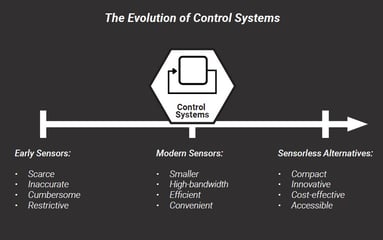Navigating the Landscape of Sensorless Controls
 This article is an excerpt from the Boston Engineering 2024 Technology Outlook. For a copy of this article and the complete publication, visit the 2024 Technology Outlook digital download page.
This article is an excerpt from the Boston Engineering 2024 Technology Outlook. For a copy of this article and the complete publication, visit the 2024 Technology Outlook digital download page.
It's fascinating to reflect on how controls technology has evolved over time, paving the way for even more advancements in the future.
Boston Engineering is keeping an eye on the continued movement toward sensorless controls, the ease of tuning control systems, and with this, the expansion of use cases and benefits of control systems, especially when teamed with communication technologies.
One fundamental component of control systems is the feedback sensor, crucial for measuring various physical parameters like position, velocity, light intensity, pressure, and more. Looking back, it's evident that earlier generations of sensors were limited in availability, bandwidth, and accuracy. They were bulkier and posed challenges in system design and integration.
Fast forward to today, and we are in possession of compact, high-bandwidth sensors that often digitize signals locally, enabling high-speed communication and eliminating noise issues over long cables. This remarkable sensor technology simplifies control system design immensely.

Despite growing smaller, sensors still contribute to cost and size concerns in systems. To address this, Boston Engineering continues to offer sensorless alternatives that rely on mathematical algorithms to 'predict' the parameter to be measured.
These systems require the ability to model the process and ample processing power. Modeling is done with simulation packages and microprocessors capable of performing millions of floating-point operations per second. While not suitable for every application, with the right design, sensorless controls can become a feature in advanced systems.
Embrace the future trends that are shaping a new era of engineering excellence.
The 2024 Technology Outlook from Boston Engineering offers an insightful glimpse into trends and innovations on the horizon. Spanning artificial intelligence, robotics, additive manufacturing, and more, this collection of articles provides key takeaways for those looking to stay ahead of the technology curve.
Download for groundbreaking insights!
Transitioning to the equally important topic of compensators, the days of soldering and unsoldering resistors and capacitors to 'tune' the compensator for desired responses are long gone. Nowadays, these PID parameters can be fine-tuned with a few lines of code on a microprocessor.
 This offers unprecedented flexibility and efficiency in achieving the desired control system responses, while also reducing testing and development time using technology.
This offers unprecedented flexibility and efficiency in achieving the desired control system responses, while also reducing testing and development time using technology.
Moreover, these emerging technologies are expanding the horizons of control systems. The ability to communicate with IoT devices has revolutionized the control landscape. This allows for the management of complex, cable-free networks of interconnected devices – a concept beyond imagination just 35 short years ago.
In summary, control system design has evolved significantly over the years. What used to be a complex and resource-intensive endeavor has become more accessible, thanks to high-speed, small-footprint sensors, powerful yet affordable microcontrollers, wireless technologies, and sophisticated simulation packages.
These advancements are making complex control systems more achievable for a wide range of applications in 2024 and beyond.
Download this article and the complete publication by visiting the 2024 Technology Outlook digital download page today.

As the engineering landscape continues to evolve, Boston Engineering is committed to proactively integrating cutting-edge technologies and methodologies into the solutions it delivers, ensuring that clients stay at the forefront of industry trends and maintain a competitive edge in 2024 and beyond.
Ready to learn more about Boston Engineering?
For almost three decades, Boston Engineering has designed, developed, and optimized devices and technologies the medical community relies on to save lives, enrich quality of life, and reduce costs to the healthcare system. We provide solutions to the challenges in the adoption of surgical robotics.
Our expertise includes industrial design and product redesign, sensors and control systems, robotics technical innovation, and digital software solutions.
Imagine your Impact: Stay up-to-date with the latest insights and trends we're watching. Add your email address below and sign up for a monthly summary of our most impactful posts!











